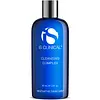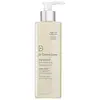What's inside
What's inside
 Key Ingredients
Key Ingredients

 Benefits
Benefits

 Concerns
Concerns

 Ingredients Side-by-side
Ingredients Side-by-side

Water
Skin ConditioningDisodium Laureth Sulfosuccinate
CleansingCocamidopropyl Betaine
CleansingPEG-30 Glyceryl Cocoate
EmulsifyingGlycerin
HumectantPropylene Glycol
HumectantHydroxyethylcellulose
Emulsion StabilisingSalix Alba Bark Extract
AstringentSaccharum Officinarum Extract
MoisturisingCamellia Sinensis Leaf Extract
AntimicrobialChamomilla Recutita Flower Extract
MaskingAsiaticoside
AntioxidantAsiatic Acid
Skin ConditioningMadecassic Acid
Skin ConditioningAscorbyl Palmitate
AntioxidantPhospholipids
Skin ConditioningTocopheryl Acetate
AntioxidantRetinyl Palmitate
Skin ConditioningIodopropynyl Butylcarbamate
PreservativePhenoxyethanol
PreservativeWater, Disodium Laureth Sulfosuccinate, Cocamidopropyl Betaine, PEG-30 Glyceryl Cocoate, Glycerin, Propylene Glycol, Hydroxyethylcellulose, Salix Alba Bark Extract, Saccharum Officinarum Extract, Camellia Sinensis Leaf Extract, Chamomilla Recutita Flower Extract, Asiaticoside, Asiatic Acid, Madecassic Acid, Ascorbyl Palmitate, Phospholipids, Tocopheryl Acetate, Retinyl Palmitate, Iodopropynyl Butylcarbamate, Phenoxyethanol
Water
Skin ConditioningGlycerin
HumectantSodium Lauroyl Methyl Isethionate
CleansingPropanediol
SolventSodium Cocoamphoacetate
CleansingCocamidopropyl Hydroxysultaine
CleansingDisteareth-75 Ipdi
Glycereth-7 Caprylate/Caprate
EmulsifyingSodium Chloride
MaskingTrisodium Ethylenediamine Disuccinate
PEG-40 Hydrogenated Castor Oil
EmulsifyingMandelic Acid
AntimicrobialGlycolic Acid
BufferingSalix Alba Bark Extract
AstringentPhytic Acid
Potassium Azeloyl Diglycinate
Skin ConditioningCitric Acid
BufferingFarnesol
PerfumingBarosma Betulina Leaf Extract
PerfumingSodium PCA
HumectantSodium Hyaluronate
HumectantTremella Fuciformis Extract
HumectantAloe Barbadensis Leaf Juice
Skin ConditioningBisabolol
MaskingHydrolyzed Soy Protein
HumectantCamellia Sinensis Leaf Extract
AntimicrobialButylene Glycol
HumectantCaprylic/Capric Triglyceride
MaskingDimethyl Isosorbide
SolventAlcohol
AntimicrobialSodium Phytate
Jasminum Officinale Flower/Leaf Extract
MaskingVitis Vinifera Fruit Extract
Skin ConditioningLavandula Angustifolia Flower/Leaf/Stem Extract
MaskingEugenia Caryophyllus Flower Extract
AstringentPolyglyceryl-3 Laurate
EmulsifyingPEG-7 Glyceryl Cocoate
EmulsifyingSodium Hydroxide
BufferingBenzoic Acid
MaskingSodium Benzoate
MaskingPotassium Sorbate
PreservativePhenoxyethanol
PreservativeWater, Glycerin, Sodium Lauroyl Methyl Isethionate, Propanediol, Sodium Cocoamphoacetate, Cocamidopropyl Hydroxysultaine, Disteareth-75 Ipdi, Glycereth-7 Caprylate/Caprate, Sodium Chloride, Trisodium Ethylenediamine Disuccinate, PEG-40 Hydrogenated Castor Oil, Mandelic Acid, Glycolic Acid, Salix Alba Bark Extract, Phytic Acid, Potassium Azeloyl Diglycinate, Citric Acid, Farnesol, Barosma Betulina Leaf Extract, Sodium PCA, Sodium Hyaluronate, Tremella Fuciformis Extract, Aloe Barbadensis Leaf Juice, Bisabolol, Hydrolyzed Soy Protein, Camellia Sinensis Leaf Extract, Butylene Glycol, Caprylic/Capric Triglyceride, Dimethyl Isosorbide, Alcohol, Sodium Phytate, Jasminum Officinale Flower/Leaf Extract, Vitis Vinifera Fruit Extract, Lavandula Angustifolia Flower/Leaf/Stem Extract, Eugenia Caryophyllus Flower Extract, Polyglyceryl-3 Laurate, PEG-7 Glyceryl Cocoate, Sodium Hydroxide, Benzoic Acid, Sodium Benzoate, Potassium Sorbate, Phenoxyethanol
 Reviews
Reviews

Ingredients Explained
These ingredients are found in both products.
Ingredients higher up in an ingredient list are typically present in a larger amount.
Camellia Sinensis Leaf Extract is derived from the leaves of the tea plant. Black tea, green tea, and oolong tea are all harvested from this plant.
This ingredient has many skin benefits:
This ingredient contains polyphenols, a strong antioxidant. Antioxidants help fight off molecules that damage skin cells.
On top of that, the antioxidants in green tea neutralize free-radicals from the sun. This gives the skin some extra UV protection, but should not replace sunscreen.
Many components of tea have anti-inflammatory properties.
Polyphenols and L-theanine help soothe the skin and reduce irritation. The caffeine in Camellia Sinensis Leaf Extract helps calm inflamed blood vessels.
Other compounds found in tea include: Vitamin Bs, linoleic acid, magnesium, calcium, iron, and zinc.
Research has shown both drinking Camellia Sinensis Leaf Tea and applying it to the skin can help boost skin elasticity and hydration. Studies also show using tea extract may reduce sebum, or oil, production.
Learn more about Camellia Sinensis Leaf ExtractGlycerin is already naturally found in your skin. It helps moisturize and protect your skin.
A study from 2016 found glycerin to be more effective as a humectant than AHAs and hyaluronic acid.
As a humectant, it helps the skin stay hydrated by pulling moisture to your skin. The low molecular weight of glycerin allows it to pull moisture into the deeper layers of your skin.
Hydrated skin improves your skin barrier; Your skin barrier helps protect against irritants and bacteria.
Glycerin has also been found to have antimicrobial and antiviral properties. Due to these properties, glycerin is often used in wound and burn treatments.
In cosmetics, glycerin is usually derived from plants such as soybean or palm. However, it can also be sourced from animals, such as tallow or animal fat.
This ingredient is organic, colorless, odorless, and non-toxic.
Glycerin is the name for this ingredient in American English. British English uses Glycerol/Glycerine.
Learn more about GlycerinPhenoxyethanol is a preservative that has germicide, antimicrobial, and aromatic properties. Studies show that phenoxyethanol can prevent microbial growth. By itself, it has a scent that is similar to that of a rose.
It's often used in formulations along with Caprylyl Glycol to preserve the shelf life of products.
Salix Alba Bark Extract comes from the white willow tree, which is native to Europe and Central Asia.
Salix Alba Bark Extract has often been described as salicylic acid's cousin. This is due to the salicin it contains. However, studies are limited showing salix alba bark to be an effective salicylic acid alternative.
Salicin does have anti-inflammatory and antioxidant properties. It has shown to decrease the formation of inflammatory mediators, such as tumor necrosis factor-α and nuclear factor-kappa B. Salicin also has a mildly exfoliating effect on the skin.
Several other components in salix alba bark extract also contain antioxidant properties, such as flavonoids and polyphenols. Antioxidants may help with anti-aging as they neutralize harmful free-radical molecules.
Willow Bark extract has been used for thousands of years. Ancient civilizations used white willow to help treat pain and fevers.
Learn more about Salix Alba Bark ExtractWater. It's the most common cosmetic ingredient of all. You'll usually see it at the top of ingredient lists, meaning that it makes up the largest part of the product.
So why is it so popular? Water most often acts as a solvent - this means that it helps dissolve other ingredients into the formulation.
You'll also recognize water as that liquid we all need to stay alive. If you see this, drink a glass of water. Stay hydrated!
Learn more about Water